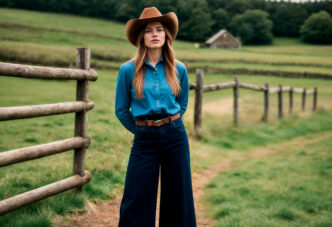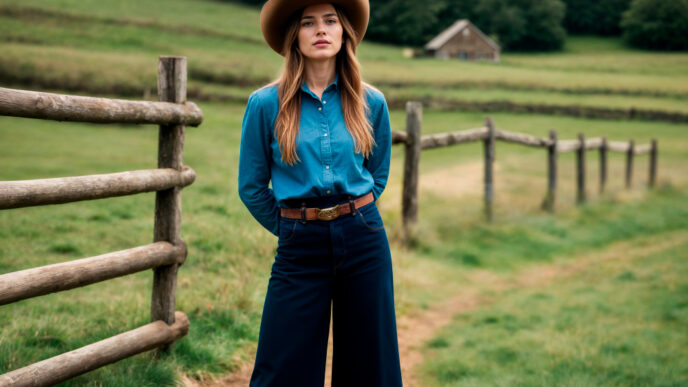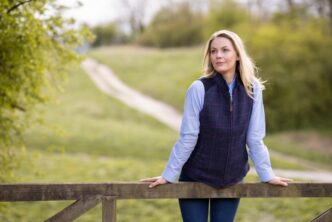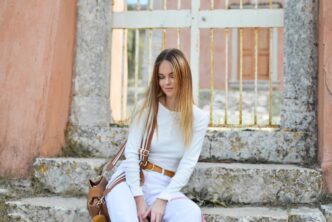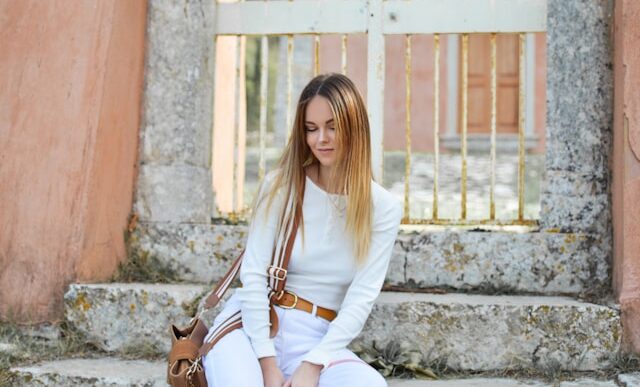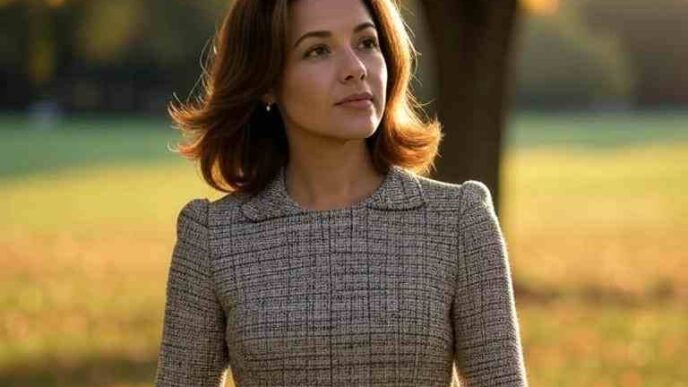Scarves represent versatile accessories that transform any outfit. These fabric pieces offer endless styling possibilities for modern women. Learning how to style scarf accessories opens up creative approaches to fashion. This guide explores practical methods for incorporating scarves into your wardrobe. You will discover techniques that work for casual days and formal events. The article covers different materials and provides seasonal advice for year-round styling success.
Top 10 Scarf Outfit Ideas
Scarves create excellent focal points for diverse styling approaches. Their adaptability allows for creative combinations across seasons. These curated ideas demonstrate various methods to incorporate this timeless accessory into your daily wardrobe.
Scarf with Blazer
A silk scarf draped elegantly over a structured blazer creates sophisticated professional styling. This combination works beautifully for business meetings and office presentations. The soft fabric adds feminine contrast to the blazer’s sharp lines while maintaining appropriate workplace polish.
Choose silk scarves in colors that complement your blazer without overwhelming the overall aesthetic. Navy blazers pair wonderfully with cream or soft pink scarves. Gray options work well with jewel tones like emerald or sapphire. The scarf should be large enough to drape naturally without appearing forced or artificial.
This scarf outfit for women demonstrates how accessories can elevate basic professional pieces. The combination feels polished yet approachable. Drape the scarf loosely around your neck, allowing one end to hang longer than the other for asymmetrical appeal. This creates visual interest while maintaining professional appropriateness.
Complete the look with tailored trousers or a pencil skirt in coordinating colors. Pointed-toe pumps or professional flats maintain the sophisticated aesthetic. Keep jewelry minimal to allow the scarf to be the primary decorative element. A structured handbag in leather complements the professional nature of this combination.
The styling works across seasons with appropriate fabric adjustments. Lighter silks suit warmer months, while heavier materials provide additional warmth during cooler periods. This versatility makes scarves valuable investments for professional wardrobes.
Scarf with Casual T-Shirt
Pairing a printed scarf with a simple t-shirt elevates everyday casual wear. This approach transforms basic pieces into stylish combinations suitable for weekend activities. The scarf adds color and pattern interest to neutral foundations while maintaining comfortable wearability.
Select cotton or modal t-shirts in solid colors that complement your scarf’s pattern. White tees provide neutral canvases for bold prints, while colored shirts can create harmonious or contrasting combinations depending on your style preferences. The t-shirt should fit well without being too tight or loose.
Scarf outfits benefit from this high-low mixing approach. The casual base allows the accessory to shine while maintaining approachable styling that works for various leisure activities. Tie the scarf in a simple knot or loop it loosely for different aesthetic effects.
Layer with denim jackets or cardigans when weather requires additional coverage. The scarf remains visible while providing continuous styling impact throughout temperature changes. This adaptability makes the combination practical for transitional seasons and varying indoor-outdoor activities.
Complete with comfortable sneakers or flat sandals depending on the season. The footwear should maintain the casual nature while providing support for daily activities. This combination demonstrates how accessories can upgrade simple pieces without sacrificing comfort or practicality.
Scarf with Little Black Dress
A colorful scarf transforms the classic little black dress into a personalized statement piece. This combination provides endless variety from a single dress foundation. The scarf adds personality while maintaining the dress’s elegant versatility across different occasions and settings.
Choose scarves in colors that complement your skin tone and reflect the occasion’s formality level. Bright colors create daytime energy, while deeper tones suit evening events. The pattern scale should coordinate with the dress’s simplicity to avoid overwhelming the classic silhouette.
Women’s scarf outfits gain sophistication through this timeless pairing approach. The black dress provides a neutral foundation that showcases the scarf’s colors and patterns effectively. Different tying methods create various looks from the same basic combination, maximizing wardrobe versatility.
Experiment with different placement options including around the neck, as a belt, or draped over the shoulders. Each position creates different visual effects and formality levels. The versatility allows one dress to serve multiple styling needs with simple accessory changes.
Complete with appropriate footwear for the occasion. Heels elevate the combination for evening events, while flats maintain daytime appropriateness. The scarf’s colors can guide shoe selection, creating cohesive looks that appear well-planned and intentional.
Scarf with Denim Jacket
A lightweight scarf layered under a denim jacket creates textural contrast and adds sophisticated touches to casual outfits. This combination works well for transitional weather when light layering becomes necessary. The scarf provides color interest while the jacket adds structure and warmth.
Select scarves in materials that layer comfortably under denim without creating bulk. Silk or thin cotton options work best for smooth layering that maintains the jacket’s intended fit. The colors should complement the denim wash while adding visual interest to the casual foundation.
How to wear scarf accessories with casual pieces requires attention to proportion and texture balance. The delicate scarf softens the denim’s utilitarian nature while maintaining the outfit’s approachable aesthetic. This creates refined casual styling suitable for various social occasions.
Position the scarf so it remains visible when the jacket is worn open or closed. This ensures the accessory continues contributing to the overall look regardless of temperature changes. The styling remains cohesive while adapting to practical needs throughout the day.
Layer over simple tops that don’t compete with the scarf for attention. Solid-colored tees or tank tops work well as neutral foundations. Complete with comfortable jeans or casual pants and supportive footwear for all-day comfort and style.
Scarf with Sweater
Draping a contrasting scarf over a solid sweater creates cozy sophistication perfect for cooler weather. This combination provides warmth while maintaining style consciousness that elevates basic knit pieces. The scarf adds color and pattern interest to potentially monotonous winter wardrobes.
Choose sweaters in neutral colors that serve as effective backdrops for patterned scarves. Gray, cream, and navy sweaters work with most scarf colors and patterns. The sweater should fit well without being too bulky, allowing the scarf to drape naturally over the knit texture.
Types of scarf for women all work with sweater combinations, though materials should complement the season and sweater weight. Wool scarves provide additional warmth, while silk options add luxury touches to casual knit foundations. Consider texture mixing for enhanced visual interest.
Experiment with different draping techniques that suit the sweater’s neckline and your personal comfort preferences. Loose draping creates relaxed aesthetics, while more structured arrangements provide polished appearances suitable for professional casual environments.
Complete with appropriate bottoms and footwear for the weather conditions. Dark jeans or wool pants work well with sweater combinations, while ankle boots or comfortable flats provide weather-appropriate foundation. The scarf’s colors can guide accessory selection for cohesive styling.
Scarf with White Button-Down
A patterned scarf elevates the classic white button-down shirt beyond basic professional wear. This combination creates sophisticated styling suitable for business casual environments and polished weekend activities. The scarf personalizes the traditional shirt while maintaining its classic appeal.
Select button-down shirts in quality cotton that maintains crispness throughout the day. The fit should be appropriate for your body type without being too tight or loose. Classic white provides the most versatile foundation for various scarf colors and patterns.
What to wear with scarf accessories includes timeless pieces that benefit from personalization. The white shirt’s neutrality allows bold scarf patterns to shine while maintaining professional appropriateness. Different tying methods create various looks from the same shirt foundation.
Consider the scarf’s scale and pattern intensity when selecting tying methods. Large prints may work better with simpler knots, while smaller patterns can accommodate more complex draping techniques. The goal is balanced visual weight that enhances rather than overwhelms the shirt’s classic lines.
Complete with tailored pants, pencil skirts, or well-fitted jeans depending on the occasion’s formality level. The scarf’s presence allows for versatile bottom choices while maintaining cohesive styling. Footwear should complement the overall sophistication level created by the scarf addition.
Scarf with Trench Coat
A silk scarf worn with a classic trench coat creates timeless sophistication reminiscent of vintage Hollywood glamour. This combination works beautifully for spring and fall when trench coats provide ideal outerwear coverage. The scarf adds luxury touches to the utilitarian coat silhouette.
Choose silk scarves in colors that complement the trench coat’s neutral tones. Classic combinations include navy scarves with beige coats or cream options with camel-colored trenches. The scarf should be substantial enough to create visual impact without overwhelming the coat’s clean lines.
Scarf outfit ideas for women often draw inspiration from classic style icons who understood accessory power. This combination channels that timeless elegance while remaining appropriate for contemporary settings. The styling works for business travel, cultural events, and sophisticated social occasions.
Position the scarf inside the coat collar for subtle elegance or wear it outside for more dramatic impact. Both approaches create different aesthetic effects while maintaining the combination’s inherent sophistication. Weather conditions and personal preferences can guide the choice.
Complete with appropriate footwear that matches the combination’s refined nature. Low heels, polished flats, or knee-high boots work depending on the season and specific outfit requirements. The overall effect should feel effortlessly elegant rather than overly constructed.
Scarf with Jeans and Tee
A colorful scarf transforms the basic jeans and t-shirt combination into a put-together casual look. This approach demonstrates how simple accessories can elevate everyday basics without requiring wardrobe overhauls. The scarf provides the elevated element that makes casual wear feel intentional.
Select well-fitted jeans in flattering cuts that serve as neutral foundations for scarf color play. Dark washes typically work best for this elevated casual approach, providing sophisticated bases that complement most scarf options. The fit should be comfortable for extended wear.
How to dress up scarf accessories with casual basics involves strategic color and pattern selection. Bold prints can energize neutral foundations, while subtle patterns add refined touches without overwhelming simple base pieces. The scarf becomes the outfit’s focal point.
Experiment with different wearing methods that suit casual aesthetics while maintaining sophistication. Loose loops, simple knots, or draped styles work well with relaxed foundations. The approach should feel effortless rather than overly formal or constructed.
Complete with versatile footwear that bridges casual and polished styling. Clean sneakers, ankle boots, or comfortable flats work depending on the day’s activities. The scarf’s presence elevates the overall look while maintaining practical wearability for daily life.
Scarf with Cardigan
Layering a lightweight scarf over an open cardigan creates dimensional styling perfect for transitional weather. This combination provides warmth options while maintaining visual interest through layering techniques. The scarf adds color contrast to potentially neutral cardigan foundations.
Choose cardigans in complementary colors that don’t compete with the scarf for attention. Neutral cardigans work well as backdrops for colorful scarves, while colored options require careful coordination to avoid clashing or overwhelming combinations. The cardigan should fit appropriately for comfortable layering.
Scarf style tips include understanding how different textures work together for enhanced visual appeal. Smooth silk scarves contrast beautifully with knit cardigan textures, while cotton scarves provide casual coordination with cotton cardigans. Texture mixing adds sophistication to simple combinations.
Position the scarf so it remains visible when the cardigan is worn open or closed. This ensures continuous styling impact regardless of temperature adjustments throughout the day. The layering should appear intentional rather than accidentally complex.
Complete with appropriate bottoms that coordinate with both the cardigan and scarf colors. The combination works with various pant and skirt options, making it versatile for different body types and personal preferences. Footwear should complement the overall casual sophistication level.
Scarf with Evening Dress
An elegant scarf transforms a simple evening dress into a sophisticated formal look. This combination works beautifully for dinner parties, cultural events, and other occasions requiring elevated styling. The scarf adds luxury touches while maintaining the dress’s elegant foundation.
Select evening-appropriate fabrics like silk, chiffon, or lightweight wool that complement formal dress materials. The scarf should enhance rather than compete with the dress’s design elements. Neutral scarves work with patterned dresses, while colored options suit solid dress foundations.
Styles of scarf for formal occasions require attention to draping techniques that suit evening wear aesthetics. Elegant wraps, sophisticated knots, or artful draping create appropriate formality levels. The styling should enhance the dress rather than distract from its elegance.
Consider the dress neckline when selecting scarf placement and styling methods. High necklines may work better with shoulder draping, while lower necklines can accommodate traditional neck styling. The goal is harmonious integration rather than competing elements.
Complete with appropriate evening accessories including elegant shoes, refined handbags, and complementary jewelry. The scarf should coordinate with other accessories for cohesive formal styling that appears well-planned and sophisticated throughout the evening event.
Types and Styles of Scarves
Understanding different scarf varieties helps you select the most appropriate options for your styling needs and personal preferences. Modern scarves come in numerous materials, sizes, and designs that accommodate different occasions and aesthetic goals.
Silk scarves represent the most luxurious and versatile option for sophisticated styling applications. These typically feature smooth textures and vibrant colors that photograph beautifully and maintain their appearance through regular wear. Quality silk scarves provide investment value through durability and timeless appeal that transcends seasonal fashion trends.
The natural sheen of silk adds elegance to both casual and formal outfits while providing comfortable wear against the skin. Various weights from lightweight to substantial allow for different seasonal applications and styling approaches. Classic sizes like 36-inch squares provide maximum versatility for various tying methods and draping techniques.
Popular silk patterns include paisley, floral, geometric, and abstract designs that coordinate with different wardrobe aesthetics. Neutral colorways provide maximum coordination flexibility, while bold patterns create statement effects for personality-driven styling approaches. Quality silk scarves often feature hand-rolled edges that indicate superior construction.
Cotton scarves offer casual alternatives with breathable properties ideal for everyday wear and warmer weather applications. These typically cost less than silk options while providing comfortable practicality for frequent use. Various weaves from lightweight voile to substantial canvas create different aesthetic effects and seasonal appropriateness.
The matte finish of cotton provides understated elegance that works well with casual and business casual styling approaches. Colors tend to be more muted than silk options, creating sophisticated palettes that coordinate easily with existing wardrobe pieces. Cotton scarves often feature more casual patterns and rustic charm.
Care requirements for cotton scarves are typically less demanding than silk options, making them practical for frequent wear and easy maintenance. Various sizes from small neck scarves to large wraps accommodate different styling needs and personal preferences for coverage and visual impact.
Wool scarves provide warmth and texture for cooler weather styling while maintaining sophisticated appearances suitable for professional and social occasions. These range from fine gauge options for layering to substantial weights for primary warmth sources. Quality wool maintains its shape and appearance through regular wear.
Different wool types from merino to cashmere provide various luxury levels and price points. Fine wools offer softness and elegance, while coarser options provide durability and rustic charm. Blended options often combine wool’s warmth with other fibers’ practical benefits for enhanced wearability.
Wool scarf patterns often reflect traditional influences including plaids, herringbone, and cable knits that provide classic appeal and versatility. Neutral colors coordinate well with winter wardrobes, while seasonal colors add personality to potentially monotonous cold-weather styling approaches.
Modal and synthetic scarves offer affordable alternatives with easy care properties that suit busy lifestyles and frequent wear needs. These materials often mimic natural fiber properties while providing practical benefits like wrinkle resistance and quick drying for travel applications.
Quality synthetic options can provide attractive appearances and comfortable wear while maintaining budget-friendly price points. Various textures from smooth to textured create different aesthetic effects that coordinate with natural and synthetic wardrobe pieces alike.
Blended fabrics combine different materials’ best properties for enhanced performance and appearance characteristics. Common blends include silk-cotton for durability, wool-cashmere for luxury, and synthetic blends for practical benefits that suit active lifestyles and demanding wear conditions.
Chiffon and lightweight fabrics provide ethereal effects perfect for romantic and feminine styling approaches. These delicate materials require careful handling but create beautiful draping effects that enhance evening wear and special occasion styling. Various transparency levels accommodate different modesty preferences and styling needs.
How To Choose The Best Scarf
Selecting the perfect scarf requires consideration of multiple factors including intended use, personal style preferences, and quality indicators that ensure satisfaction and versatility. The goal involves finding pieces that complement your existing wardrobe while providing styling flexibility for various occasions.
Begin by determining your primary intended uses for the scarf. Fashion applications emphasize appearance factors like color coordination and pattern appeal, while functional needs prioritize warmth and weather protection. Understanding your priorities helps narrow options effectively and ensures satisfaction with your selection.
Consider your typical outfit colors and patterns when selecting scarf options that will coordinate well with existing wardrobe pieces. Neutral scarves provide maximum versatility for various outfit combinations, while bold patterns can create statement effects but may limit coordination possibilities with existing clothing.
Evaluate different materials based on your climate, lifestyle, and care preferences. Natural fibers like silk and wool provide luxury and classic appeal but may require special care. Synthetic options offer practical benefits like easy washing and durability but may lack the sophistication of natural materials.
Assess size options based on your preferred wearing methods and coverage needs. Large scarves provide maximum versatility for various tying techniques and draping styles, while smaller options offer subtle accents that won’t overwhelm petite frames or simple outfits.
Consider pattern scale and complexity in relation to your typical clothing choices and personal style preferences. Large patterns work well with solid clothing foundations, while small prints can coordinate with various patterns when carefully selected for harmonious color relationships.
Examine construction quality including edge finishing, fabric weight consistency, and overall craftsmanship that predict durability and maintained appearance through regular wear. Quality indicators include hand-rolled hems on silk scarves and consistent fabric weight throughout the piece.
Seasonal Style Guide for Scarves
Scarves adapt beautifully to seasonal styling changes with appropriate material selection and wearing techniques. Understanding seasonal applications ensures year-round versatility while maintaining style appropriateness for different weather conditions and fashion expectations.
Spring styling emphasizes lightweight fabrics and fresh colors that reflect the season’s renewal energy and transitional weather patterns. Cotton and silk scarves work particularly well during spring months, providing comfortable coverage without excessive warmth that might cause discomfort during temperature fluctuations.
Light colors including pastels, soft neutrals, and fresh brights coordinate beautifully with spring wardrobes while creating optimistic combinations that reflect seasonal mood changes. Floral patterns feel particularly appropriate during spring months when nature provides similar inspiration and garden themes dominate fashion trends.
Spring scarf applications focus on lightweight layering that provides versatility for changing weather conditions throughout unpredictable days. Loose draping and simple knots work well for easy adjustment as temperatures fluctuate between morning coolness and afternoon warmth.
Layer spring scarves with light cardigans, denim jackets, or blazers for complete transitional weather coverage that adapts to various indoor and outdoor conditions. The accessories provide personality touches that enhance seasonal styling approaches while maintaining practical temperature control.
Summer approaches require careful material selection to maintain comfort during warmer temperatures while preserving style consciousness for air-conditioned environments and evening cooling. Lightweight fabrics like cotton voile, silk chiffon, or linen provide breathable options that won’t cause overheating.
Summer colors should reflect the season’s bright energy while providing sun protection for delicate neck and shoulder areas. Bright colors, tropical patterns, and nautical themes coordinate well with summer wardrobes while adding personality to potentially minimal warm weather outfits.
Summer applications emphasize sun protection and air conditioning preparation rather than warmth provision. Loose draping and minimal coverage work best for hot weather while maintaining accessory impact for style enhancement during social and professional summer activities.
Consider tying scarves around handbag handles or wearing them as headbands during extremely hot weather when neck coverage becomes uncomfortable. These alternative applications maintain style consciousness while adapting to practical summer comfort needs.
Autumn styling allows richer colors and substantial fabrics that coordinate with the season’s sophisticated aesthetic and cooler temperature requirements. Wool, cashmere, and heavier silk scarves provide appropriate warmth while maintaining luxury touches that enhance autumn wardrobes.
Autumn colors including deep burgundy, forest green, rich brown, and golden yellow reflect natural seasonal changes while providing sophisticated palettes that coordinate with heavier clothing textures and darker color schemes typical of fall fashion approaches.
Autumn applications include substantial layering that provides real warmth while maintaining style consciousness appropriate for professional and social occasions. Complex draping techniques and structured knots work well with heavier fabrics and substantial clothing foundations.
Layer autumn scarves with wool coats, leather jackets, and substantial sweaters for complete cold weather coverage that maintains style impact. The accessories should coordinate with other seasonal accessories like hats and gloves for cohesive autumn styling approaches.
Winter styling requires substantial fabrics and practical coverage that provides real warmth while maintaining sophisticated appearances suitable for professional and social winter activities. Wool, cashmere, and thick silk scarves offer necessary protection while preserving luxury aesthetics.
Winter colors should coordinate with heavy outerwear and indoor heating considerations. Deep colors, rich patterns, and classic plaids provide sophisticated options that work well with dark winter coats while maintaining visibility and style impact during shortened daylight hours.
Do’s and Don’ts of Wearing Scarves
Understanding key principles for wearing scarves successfully helps create polished looks while avoiding common mistakes that can compromise their style potential. These guidelines ensure scarves enhance rather than detract from your overall appearance and fashion goals.
Do choose scarf colors and patterns that complement your skin tone and coordinate harmoniously with your existing wardrobe pieces. The accessory should enhance your natural coloring while working well with clothing colors you typically wear. This ensures maximum versatility and flattering presentations across various outfit combinations.
Proper color coordination creates intentional looks that appear well-planned rather than accidentally assembled. Consider undertones in both your skin and clothing when selecting scarf options that will work well across multiple styling scenarios and seasonal changes.
Understanding which colors enhance your natural features helps build confidence in scarf selection and wearing techniques. Quality scarves represent investments that should provide long-term styling value and personal satisfaction through regular wear and various applications.
Do invest in quality materials and construction that maintain appearance and functionality through regular wear and proper care routines. Quality scarves provide better draping, color retention, and overall satisfaction while justifying higher initial costs through extended wear life and maintained beauty.
Natural fibers typically provide superior draping characteristics and aging properties compared to synthetic alternatives. The investment in quality pieces pays dividends through improved appearance and increased styling versatility that makes scarves valuable wardrobe additions.
Quality construction includes appropriate edge finishing, consistent fabric weight, and durable materials that withstand regular use and care requirements. These factors contribute significantly to long-term satisfaction and continued attractive appearance through multiple seasons of wear.
Do experiment with different tying methods and placement options to discover what works best for your body type, personal style preferences, and typical outfit combinations. Practice with various techniques builds confidence and skill that enhances overall styling success and personal expression through accessories.
Different body types benefit from different scarf placement and tying methods. Understanding what works best for your proportions helps create more flattering presentations and increased comfort with wearing scarves regularly for various occasions and styling needs.
Regular experimentation helps develop personal styling signatures that feel authentic while maintaining appropriateness for different social and professional contexts where scarf wearing demonstrates style consciousness and attention to detail.
Don’t choose scarves that overwhelm your frame or compete excessively with other outfit elements for visual attention. The accessory should enhance rather than dominate your overall appearance while maintaining harmonious relationships with clothing colors, patterns, and proportions.
Proportion considerations become particularly important for petite frames that can be overwhelmed by large scarves or bold patterns. Understanding scale relationships helps ensure flattering presentations that enhance rather than diminish your natural attributes and styling goals.
Balance between making style statements and maintaining wearable sophistication requires attention to overall outfit composition. The scarf should contribute positively to complete looks rather than creating competing focal points that detract from cohesive presentations.
Don’t ignore practical considerations including comfort, weather appropriateness, and activity suitability when selecting and wearing scarves for different occasions and environmental conditions. The accessory should enhance your comfort and confidence rather than creating restrictions or discomfort.
Weather-appropriate material selection ensures comfort throughout wear periods while maintaining style consciousness. Choosing fabrics and weights suitable for conditions prevents discomfort that could affect confidence and enjoyment of activities and social interactions.
Activity considerations help determine appropriate scarf sizes, tying methods, and placement options that won’t interfere with movement or create safety concerns during various pursuits. Practical styling ensures both appearance and functionality goals are met successfully.
Don’t neglect proper care and storage that preserve scarf appearance and extend useful life while protecting investments in quality accessories. Different materials require specific care approaches that maintain color, texture, and overall appearance through regular use and seasonal storage periods.
Appropriate care prevents common problems like color fading, texture deterioration, and shape distortion that can compromise scarf appearance and styling effectiveness. Understanding material-specific requirements helps maintain investment value and continued satisfaction with quality pieces.
Proper storage techniques prevent wrinkles, moth damage, and other issues that can affect scarf appearance and usability. Organized storage also makes scarves more accessible for regular use and styling experimentation that maximizes their wardrobe value and personal expression potential.
7 Tips on How to Wear Scarves
Mastering scarf styling requires understanding specific techniques that maximize their versatility while maintaining sophisticated appearances across various occasions. These essential tips help create confident, stylish presentations that showcase scarves’ potential for personal expression and outfit enhancement.
The first tip focuses on mastering basic tying techniques that create different aesthetic effects while ensuring secure, comfortable wear throughout daily activities. Simple knots work well for casual applications, while more complex arrangements suit formal occasions and sophisticated styling approaches that require elevated accessory presentations.
Practice basic techniques including the simple loop, classic knot, and draped styles until they become second nature. Consistent execution creates professional appearances that demonstrate style competence and attention to detail in personal presentation across various social and professional contexts.
Understanding which techniques work best for different scarf sizes and materials helps ensure successful styling outcomes. Heavy fabrics may require simpler approaches, while lightweight materials can accommodate more complex arrangements that showcase the fabric’s draping characteristics and visual appeal.
The second tip emphasizes proportion awareness when selecting scarf sizes and styling methods that complement your body type and typical outfit combinations. Large scarves can overwhelm petite frames, while small options may appear insignificant on taller or broader figures.
Consider your neck length, shoulder width, and overall proportions when choosing scarves and styling approaches that create flattering presentations. The accessory should enhance your natural attributes rather than creating unflattering relationships that detract from your overall appearance and confidence.
Understanding proportion relationships helps build confidence in scarf selection and wearing techniques while ensuring consistently flattering results across different styling scenarios and personal expression goals that reflect individual aesthetic preferences.
The third tip involves understanding color coordination principles that create harmonious outfit combinations while avoiding clashing or competing visual elements that can compromise overall styling effectiveness. Color relationships significantly impact the success of scarf integration into existing wardrobe pieces.
Complementary colors create vibrant contrast that energizes outfits, while analogous combinations provide subtle harmony that enhances overall aesthetic cohesion. Understanding color theory basics helps make confident selections that consistently produce attractive results across various styling applications.
Consider your skin tone and hair color when selecting scarf colors that enhance your natural coloring while coordinating well with typical clothing choices. This knowledge helps build a versatile scarf collection that works across multiple outfit combinations and seasonal styling needs.
The fourth tip focuses on material selection based on intended use, climate conditions, and care preferences that affect long-term satisfaction and practical wearability. Different materials provide various benefits and limitations that should align with lifestyle needs and aesthetic goals.
Natural fibers offer luxury and classic appeal but may require special care and higher initial investments. Synthetic options provide practical benefits like easy care and durability but may lack the sophistication and draping characteristics of natural materials that enhance styling success.
Understanding material properties helps make informed selections that align with personal priorities including appearance, functionality, and maintenance requirements. This knowledge ensures satisfaction with scarf investments and increased likelihood of regular wear that maximizes wardrobe value.
The fifth tip emphasizes seasonal adaptation that allows scarves to work effectively year-round while maintaining appropriate weather responsiveness and style consciousness. Different seasons require different approaches to material selection, color choices, and wearing techniques that suit weather conditions.
Lightweight materials work well for spring and summer applications, while substantial fabrics provide necessary warmth during autumn and winter months. Understanding seasonal appropriateness helps ensure comfort and style success across different weather conditions and fashion expectations.
Seasonal color coordination reflects natural changes and fashion trends while maintaining personal style consistency. Adapting scarf selections to seasonal palettes enhances outfit coordination and demonstrates style awareness that contributes to overall fashion competence and personal presentation.
The sixth tip involves understanding occasion appropriateness that ensures scarf styling suits different social and professional contexts while respecting dress codes and cultural expectations. Different situations require different approaches to scarf selection and wearing techniques.
Professional environments may require subtle, sophisticated approaches that enhance rather than distract from business appropriateness. Social occasions may allow for more creative expression and bold styling choices that reflect personality while maintaining suitable respect for context and expectations.
Understanding contextual requirements helps ensure scarf styling choices support rather than undermine goals in various situations where appropriate appearance contributes to social and professional success and personal confidence in different environments.
The seventh tip focuses on building personal style signatures through consistent approaches that reflect individual aesthetic preferences while maintaining appropriateness for different contexts and occasions. Developing recognizable styling approaches creates authentic personal expression while demonstrating style competence.
Experiment with different techniques and color combinations to discover what feels most authentic and flattering for your individual characteristics and lifestyle needs. Personal style development requires time and practice to achieve confident, consistent results that feel natural and appropriate.
Building confidence through regular practice and experimentation helps create authentic personal styling approaches that feel comfortable and appropriate across various situations while maintaining individual expression and aesthetic goals that reflect personal values and preferences.
Best Alternatives to Scarves
While scarves offer exceptional versatility and styling potential, several alternatives provide similar accessory benefits with different aesthetic approaches and functional characteristics. Understanding these options helps expand accessory choices while maintaining similar outfit enhancement and personal expression capabilities.
Statement necklaces provide focal point accessories that create similar visual impact to colorful scarves while offering different styling approaches and aesthetic effects. These work particularly well with simple outfits that benefit from decorative elements without fabric bulk or layering complications.
Choose statement necklaces in colors and styles that coordinate with existing wardrobe pieces while providing the personality enhancement that scarves typically offer. Quality pieces provide investment value through durability and timeless appeal that transcends seasonal fashion trends and temporary style preferences.
Style statement necklaces with solid-colored tops and dresses that provide neutral backgrounds for decorative elements. The accessories should enhance rather than compete with clothing patterns or colors while creating focal points that demonstrate style consciousness and personal expression.
Lightweight cardigans offer layering alternatives that provide similar styling versatility and temperature control benefits as scarves while offering different aesthetic approaches and coverage options. These work well for those who prefer structured layering over draped accessories.
Select cardigans in colors and styles that coordinate with existing wardrobe pieces while providing the versatility and outfit enhancement that scarves typically deliver. Quality construction ensures maintained appearance and functionality through regular wear and care cycles.
Shawls and wraps provide substantial alternatives that offer greater coverage and warmth while maintaining sophisticated appearances suitable for formal and casual occasions. These work particularly well for evening events and cooler weather applications where substantial coverage becomes necessary.
Conclusion
Scarves represent timeless accessories that successfully enhance personal style while providing practical benefits across seasons and occasions. This comprehensive scarf style guide has explored various approaches to incorporating these versatile pieces into modern wardrobes while maximizing their styling potential and personal expression capabilities.
The key to successful scarf styling lies in understanding quality selection, mastering basic techniques, and building confidence through regular experimentation with different approaches that reflect individual aesthetic preferences while maintaining appropriateness for various social and professional contexts where style consciousness contributes to personal success.


